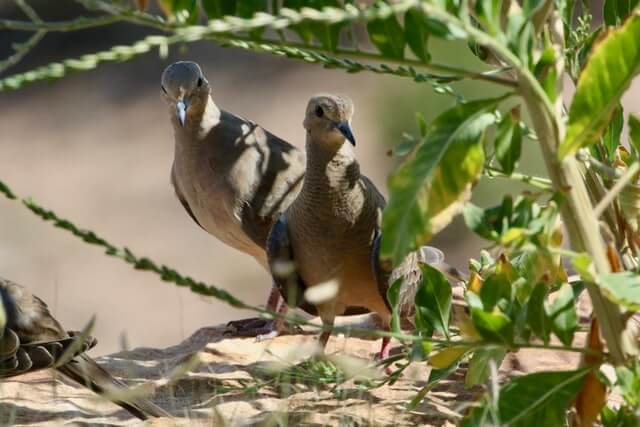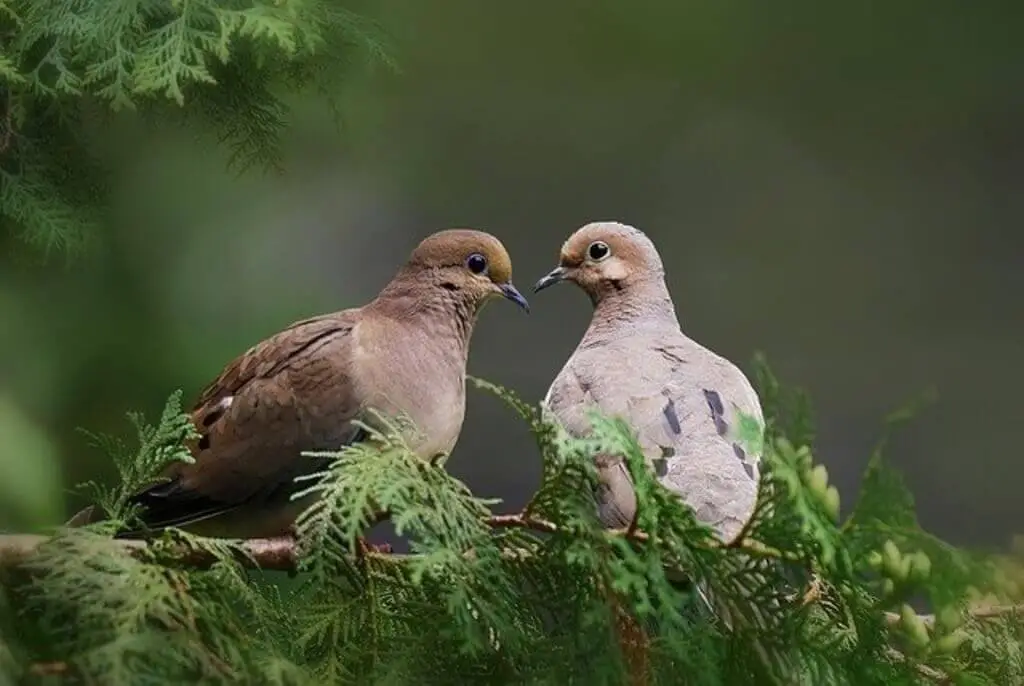
Mourning doves are one of the most common birds in North America. Though they are often considered to be pests, they are actually very interesting creatures.
In this comprehensive guide, we will explore some fun facts about mourning doves, including their identification, sounds and calls, maps and more.
So whether you’re a bird lover or just curious about these feathered creatures, read on for everything you need to know about mourning doves.
Table of Contents
Interesting Facts About Mourning Doves
When You’re Likely to Spot Them
In North America they are seen from April to October, but in Europe the bird appears as early as March. This beautiful bird was once considered to be an important symbol of peace by the Native Americans who lived in North America.
Where They Live
The Mourning Dove ranges throughout North America, from Alaska and Canada to Mexico. In the United States, it is the most widespread and abundant dove species.
Distribution Maps (Source)
Preferred Environments
Mourning doves are found in a variety of natural habitats such as water, wetlands and marshlands. They prefer to live in milder parts of North America including parks, prairies, roadsides, yards, farmland and suburbs.
Doves can be seen all year round, but they are most common during the spring months, when they migrate from the south to northern states for breeding season.
Their population is generally small, so you won’t see them very often even if you know where to look for them. These birds mainly live their lives on the ground; they don’t often fly high up into trees or nests because they like being near water sources for food and cover.
What They Eat
Mourning Doves live on the ground and eat mostly seeds, grain, peanuts, wild grasses, berries and weeds which they find on the ground.
Mourning Doves are herbivores which means they only eat plants but if the opportunity arises then they will consume insects or earthworms, caterpillars or snails.

The Sounds They Make
Of all the birds in North America, the Mourning Dove is one of the most commonly heard. Its distinctive coo is a familiar sound in many backyard and open habitats across the continent. But what does this bird’s call actually mean?
Contrary to its name, the Mourning Dove doesn’t primarily use its call to communicate sadness or grief. Instead, this cooing serves as a way for pairs of doves to maintain contact with each other.
The males and females will often take turns calling back and forth to one another, sometimes for hours at a time. In addition to its well-known coo, the Mourning Dove also makes a number of other sounds.
These include soft clicks and trills that are used as alarm calls, as well as sharp wing noises that serve to startle predators.
Mourning Dove Sounds (Source)
Nesting Habits
They can be found in all sorts of habitats, but prefer trees and bushes to build their nests. Their nesting cycle starts with the female mourning dove choosing a mate from within her flock.
Once she chooses her mate they start building their nest together which is made up of pine needles, grasses, twigs, leaves, vines or any other material available at the time.
Nesting sites vary depending on where they are found: they usually nest on the ground but sometimes will also use eaves troughs or even gutters as nesting sites.
Mourning Dove’s nest can be found all over North America (southern Canada to northern Mexico) during the summer months and Central America during winter months.
Mourning Doves are birds that nest in the spring and summer. They typically have one brood per year, but may have up to seven broods. Their clutch size is 2-3 eggs and they incubate for 15 days before their young hatch.
Once hatched, the baby doves will live with their parents for 10-15 days until they can fly on their own. Mourning Doves may have the most complex nesting cycle of any bird species.
- Clutch Size: 2 -3 eggs
- Amount of Broods: 1-7 broods
- Egg Width: 0.9-1.0 in (2.2-2.5 cm)
- Egg Length: 0.9-1.3 in (2.2-3 cm)
- Incubation Length: 15 days
- Nestling Length: 10-15 days
- Color of Egg: White
Attracting Mourning Doves
Mourning Doves, known for their soft cooing and gentle demeanor, are a charming addition to any backyard. Attracting these graceful birds requires creating a welcoming environment that meets their specific needs.
1. Provide the Right Food
Mourning Doves are ground feeders and prefer to eat seeds, particularly black-oil sunflower seeds, millet, cracked corn, and safflower seeds. Offering these in a ground feeder or a large, flat tray can help attract them. Scatter some seeds on the ground as well to appeal to their natural foraging habits.
2. Choose the Right Feeder
While Mourning Doves are primarily ground feeders, they will also visit platform feeders or large tray feeders that offer plenty of space. Ensure the feeder is stable and low to the ground, as these birds prefer feeding in open spaces where they can easily spot potential threats.
3. Create a Safe Habitat
Mourning Doves are attracted to areas that provide safety and comfort. Plant dense shrubs or small trees where they can roost and build their nests. Native plants that offer cover from predators and harsh weather conditions are ideal.
4. Offer a Water Source
A birdbath is a great way to attract Mourning Doves. Ensure the birdbath is shallow, with a gentle slope, as doves prefer to wade in the water. Position the birdbath in a quiet area of your yard, away from heavy foot traffic, to encourage the doves to visit regularly.
5. Maintain a Peaceful Environment
Mourning Doves are shy birds that thrive in calm, quiet environments. Reduce loud noises and keep the area around their feeding and nesting sites tranquil. This peaceful atmosphere will make them more likely to settle and stay in your yard.
FAQs:
Do Mourning Doves mate for life?
Mourning Doves are loyal birds, some pairs stay together through the entire breeding season and some are monogamous, which means that they will stay with the same mate their whole life. A recent study was conducted to see if they do actually mate for life.
The research found that most of the doves studied did indeed find a lifelong partner and had no intention of leaving them in favor of another dove during mating season or otherwise.
Do Mourning Doves migrate?
Mourning doves are a migratory bird that spend winter in the Southern states and Mexico, even flying as far south as Central America. They migrate mainly to avoid cold temperatures that they cannot withstand, and also because of natural food sources disappearing during the colder months in North America.
This can be seen by their migration patterns to warmer climates when they return north for breeding season in the spring.
How long do Mourning Doves live?
Mourning doves live on average 1.5 -2 years in the wild due to illness and predators. Although, there have been cases where this bird has lived up to 19 years. In captivity, they can live up to 10–15 years, but their lifespan is shorter because of natural predators such as hawks, owls, and foxes, and diseases that exist in the wild.
In conclusion, they are considered short-lived birds, with an average lifespan of one year or less if they’re not taken care.
What does a Mourning Dove sound like?
These birds usually make seven different types of calls: coo-co ,chee-chee-, pee-pee-, weerp, weeep, teweeep, and pooouit. The “coo-co” call is the most common among mourning doves in, which they use to communicate with other doves as well as potential mates.
They produce coo-co call sounds over and over again, with each one getting progressively louder. It starts off with softer notes and then grows in volume, sounding almost like someone has been tapping a drum near you for hours.
What kind of seeds doing Mourning Doves eat?
Mourning Doves love seeds. But some seeds are more loved than others. Black oil sunflower seeds, milo, cracked corn, wheat white millet, peanuts and canary seed are among the favorite seeds. The Mourning Dove has been observed to consume large quantities of these particular types of food sources.
They will often seek out as many as they can find when given the opportunity to eat them freely from a platform feeder or on the ground.
What do mourning doves eat in winter?
The question that many birders have is what do mourning doves eat in winter? The answer is not very much! Mourning doves will often forage on the ground or off of branches, but their main food source during this time are suet cakes.
Suet cakes can be purchased at any feed store and usually come with a mixture of seeds such as safflower, sunflower, corn, and millet. They should be hung from tree limbs about 4-5 feet high.


